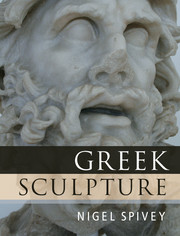Book contents
- Frontmatter
- Dedication
- Contents
- List Of Figures
- Preface
- Note
- 1 Introduction: the Study Of Greek Sculpture
- 2 The Greek Revolution
- 3 Daedalus and the Wings of Technê
- 4 Anathêmata: Gifts for the Gods
- 5 Heroes Apparent
- 6 Temple Stories
- 7 In Search of Pheidias
- 8 Revealing Aphrodite
- 9 Royal Patronage
- 10 Portraits and Personifications
- 11 Graecia Capta
- 12 Afterlife
- Index
4 - Anathêmata: Gifts for the Gods
Published online by Cambridge University Press: 01 December 2014
- Frontmatter
- Dedication
- Contents
- List Of Figures
- Preface
- Note
- 1 Introduction: the Study Of Greek Sculpture
- 2 The Greek Revolution
- 3 Daedalus and the Wings of Technê
- 4 Anathêmata: Gifts for the Gods
- 5 Heroes Apparent
- 6 Temple Stories
- 7 In Search of Pheidias
- 8 Revealing Aphrodite
- 9 Royal Patronage
- 10 Portraits and Personifications
- 11 Graecia Capta
- 12 Afterlife
- Index
Summary
Most Greek sculpture was originally intended for installation in one sanctuary or another; and it is obligatory for us to remind ourselves that however ‘picturesque’ the ruins of a Greek sanctuary may now appear, what we know of ancient Greek cult practice is not pretty. The principal activity within cult precincts was animal sacrifice: the killing of cattle, sheep, goats and pigs was carried out on a daily basis, and occasionally on a large scale (a deity honoured as hekatomboios, such as Zeus at Olympia, was literally ‘worth a hundred oxen’). Slaughtering techniques were basic – an axe-blow to the skull, and/or a knife-slash to the throat – and beyond the sight of blood, the smell of death and the shouts of worshippers, we must add the piercing sound of animals in panic. A detail of the Parthenon frieze, poetically saluted as ‘that heifer lowing at the skies’ (in Keats’ Ode on a Grecian Urn), patently evokes that panic (Figure 4.1).
It was Christian doctrinal disdain for this custom that caused the formal closure of many Greek sanctuaries in the late fourth century AD (Christ's own blood was sufficient: cf. Hebrews 10.12). But of course the practice of animal sacrifice is only one aspect of Greek sanctuaries that creates a categorical and imaginative distance between ourselves and the past. We now tend to separate ‘religion’ from day-to-day business in a way that immediately makes it difficult for us to sympathize with a society in which the distinction between ‘the sacred’ and ‘the secular’ was often obscure. Ancient Greece, arguably, was like that; and whatever the relative status of matters that were deemed ‘sacred’ and those that were not, the fact remains that a predominant quantity of Greek sculpture comes from sanctuaries: so the challenge of understanding Greek sculpture must include the effort of recreating, in the mind's eye, how the sanctuaries of Classical antiquity once flourished and, in particular, how far the presence of sculpture contributed to their prodigious, albeit transient, success.
Anathêmata, ‘things set up’, is the generic Greek term for these offerings: the lexicon reminds us that in archaic usage – for Homer, at least – the meaning more broadly entails ‘ornaments’ that bring delight: to mortals and deities alike.
- Type
- Chapter
- Information
- Greek Sculpture , pp. 86 - 121Publisher: Cambridge University PressPrint publication year: 2013



